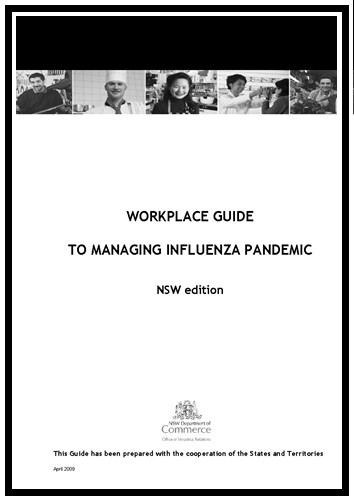Some time ago SafetyAtWorkBlog was critical of OHS regulators releasing swine flu information because the advice was not being easily translated in the workplace, and some of the advice was just silly.
 Much better advice is available from the New South Wales government however, curiously, the Workplace Guide to Managing Influenza Pandemic has been issued by the Department of Commerce. The department’s Office of Industrial Relations has released the document which makes more sense however the release seems to be contrary to WorkCover New South Wales who defers to the NSW Health Department, surely the most logical central point for communication on this public health issue.
Much better advice is available from the New South Wales government however, curiously, the Workplace Guide to Managing Influenza Pandemic has been issued by the Department of Commerce. The department’s Office of Industrial Relations has released the document which makes more sense however the release seems to be contrary to WorkCover New South Wales who defers to the NSW Health Department, surely the most logical central point for communication on this public health issue.
There are too many “experts” on the workplace impact of swine flu influenza and pandemics. SafetyAtWorkBlog has kept out of this issue as we share the position of WorkCover NSW – defer to the State or National authorities.
However, some companies feel obliged to be seen to be doing something, anything, about swine flu and their half-cocked measures are discrediting their overall process of safety management.
One national company recently issued a new policy advice to all staff on swine flu. The policy was little more than a cut and paste from an official fact sheet. It added little to the employees’ knowledge of the hazard and in no way answered staff questions such as
- If my child’s school is closed due to a swine flu threat, what type of leave am I entitled to take?
- The company has provided annual influenza vaccinations. Will I need re-vaccinating in the event of swine flu and will the company cover this cost?
- In what circumstances can my employer send me home?
Not only was it next to useless, the company had the cheek to include its own corporate logo on the policy. Public health and OHS information is usually flexible in its reuse but somebody in the company looks like they are empire-building rather than managing their staff.
People want advice on how swine flu will disrupt their lives and working lives, not information on swine flu itself. Employers should leave the health information to the health authorities and concentrate on the management of the disruption and potential health threats within their area of expertise, their own workplaces.
If employers raise expectations by issuing policies in areas outside of their expertise, they begin a spiral of the demand for information that it may be impossible to satisfy.

![HSS0075-Real -3.477447e+266state-Property 51804944nspection afety[1] HSS0075-Real -3.477447e+266state-Property 51804944nspection afety[1]](http://safetyatworkblog.files.wordpress.com/2009/05/hss0075-real-3-477447e266state-property-51804944nspection-afety1.jpg?w=212)